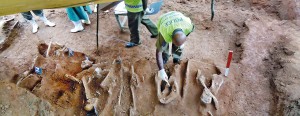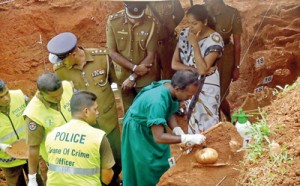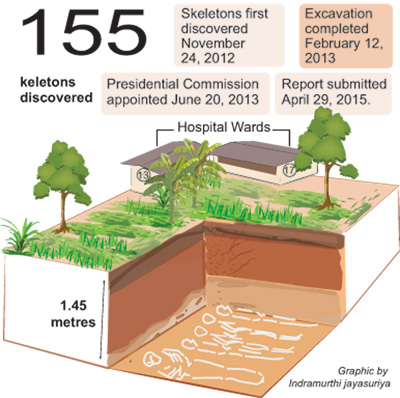News
Skeletal remains have no connection to 1989-1990 disappearances: PCI
The skeletal remains recovered from the Matale mass grave have no connection whatsoever to the disappearances during the period 1989-1990, the Presidential Commission of Inquiry has concluded, based on the scientific analysis done at a reputed laboratory in the USA, that found the “skeletons belong to an era prior to year 1950″.

155 human skeletons were found in a mass grave in Matale in November 2012, when the ground was being dug to build a new bio-gas unit at a Hospital
However, the Commission found sufficient evidence to accept that the persons found in the mass grave had been “subjected to severe torture prior to their deaths, making it obvious that they were victims of a gruesome mass murder”. The Commission was unable to find any evidence with regard to the identity of the victims or the perpetrators. “There is no evidence of either the identity of the perpetrators of the heinous crime or the reasons as to why these unfortunate persons had been killed in a brutal manner,” the Commission said.
A total of 155 human skeletons were found in a mass grave in Matale in November 2012, when the ground was being dug to build a new bio-gas unit at the Hospital, using heavy earth-moving machinery. The human skeletons had been found at a depth of around 1.45 metres beneath the surface. Some of the skeletons had were damaged by the heavy machinery. Former President Mahinda Rajapaksa appointed the three-member Commission in June 2013, to inquire and report on these findings.
The Commission was headed by Retired Judge of the Supreme Court Justice S.I Imam while the other two members were former Secretary General of Parliament Dhammika Kithulgoda and Retired High Court Judge Bandula Atapattu. The final report of the Commission was handed over to the President’s Secretary, P.B. Abyekoon on April 29.
The Sunday Times gained exclusive access to the report’s findings. The Commissioners had visited Matale during the course of its investigations and recorded the evidence of 67 witnesses, of whom 47 were persons who had filed affidavits in the Magistrate Court in Matale following the discovery of the mass grave, claiming the bodies could be those of their loved ones who disappeared during the JVP insurrection of ’89-’90. The other 20 witnesses were government officers who are either retired or still in service.
 There was evidence by only one witness named M.G. Punchibanda Herath who, in his testimony said, he had seen a mass grave at the same site in 1971. An insurrection by the JVP that year led to a brutal crackdown by the then government.Punchibanda Herath in his evidence, said that, during the insurrection of 1971, he was trying to find the whereabouts of a Buddhist monk named Wimalaratne Thera who had been arrested by the Police. Having heard about the existence of the open grave within the hospital premises from a police officer, he had proceeded to the Matale Hospital with the intention of finding out if the monk’s remains would be found from among those in the grave.
There was evidence by only one witness named M.G. Punchibanda Herath who, in his testimony said, he had seen a mass grave at the same site in 1971. An insurrection by the JVP that year led to a brutal crackdown by the then government.Punchibanda Herath in his evidence, said that, during the insurrection of 1971, he was trying to find the whereabouts of a Buddhist monk named Wimalaratne Thera who had been arrested by the Police. Having heard about the existence of the open grave within the hospital premises from a police officer, he had proceeded to the Matale Hospital with the intention of finding out if the monk’s remains would be found from among those in the grave.
At the hospital he had seen an open pit, approximately 10×10, which held about 10 bodies in a highly decomposed state. As Punchibanda stated he could point out the location of the pit to the members of the Commission, Police Inspector (IP) Wickramasekera accompanied him in a police vehicle and allowed him independently locate the grave he had referred to in his evidence. Herath arrived at the hospital premises and was able to identify the exact location of the grave as the place he had seen the pit in 1971. IP Wickramasekera confirmed that the latter was able to locate the site independently without any assistance from him.
Dr Ajith Jayasena, Consultant Judicial Medical Officer, Matale, at the time these skeletal remains were found, and who submitted a report of his findings to Court, also gave evidence before the Commission.
The excavation had taken place under his supervision. At his request, Prof Raj Somadeva, Consultant Field Archeologist of the University of Kelaniya, visited the site to conduct investigations. Dr Jayasena in his evidence stated that some of the bodies were placed in a row, while others were placed on top of each other. On examining some of the bodies, he had observed that the victims were subjected to torture. This, his report to Court stated, was proved by the injuries found in the skeletal remains, such as decapitation, dismemberment of limbs, cutting of skulls with saws and nailing the toes. In one skeleton he had seen a metal noose in the left leg which, according to Prof Somadeva, is an adjustable device when fixing an interlock known as the “hangman’s knot”.
Both Dr Jayasena and Prof Somadeva had recommended radiocarbon bomb-pulse method be used in determining the timeframe during which the bodies had been buried, as it is the only method generally accepted worldwide, to determine the time period in testing skeletal remains of recent origin.
Prof Somadeva had also recommended that the only laboratory in the world which could perform this test is Beta Analytics Inc. in Miami, Florida, to which samples were sent for testing. Assistance was sought from Dr Douglas Ubelaker, an American forensic anthropologist, for the interpretation of the results of the radiocarbon analysis, and he had concluded that the skeletons belong to an era prior to 1950.
The Commission’s report said that none of the 47 witnesses who testified before it could offer any positive information connecting the deaths of their loved ones, which had presumably occurred during the 1989-90 period, to the mass grave.
There was nobody who had seen the grave, the creation of which would have taken a considerable period of time. The Commission also noted that activities connected with the mass grave could not possibly have gone unnoticed, considering that it is situated within the hospital premises which is located in the heart of the city.
Two witnesses, namely W.G. Heenappu and L.B. Herath who had been serving as minor staff of the hospital during the period in question, had no knowledge whatsoever about the creation of the mass grave. A.S.M. Washir who had served as the Grama Niladhari of the relevant area at the time, also told the Commission he was unaware of any such activity within the hospital premises. Dr H. Kusumpala who served as the District Medical Officer and who had full responsibility of the hospital premises, had also denied having knowledge of any wrongdoing of this nature within the hospital premises.
 In the case of the 47 witnesses, they had testified that their loved ones were, in a majority of cases, abducted by unknown persons during the ’89-’90 period, and that, in certain instances, had been taken away by persons in uniforms similar to those worn by military personnel or police. In most instances, they had been taken in for questioning with the assurance they would be released later. Having exhausted all possible avenues of tracing their missing loved ones, these witnesses had seen the appointment of the Presidential Commission to investigate into the mass grave as a fresh window of opportunity, and come forward to testify with renewed hope.
In the case of the 47 witnesses, they had testified that their loved ones were, in a majority of cases, abducted by unknown persons during the ’89-’90 period, and that, in certain instances, had been taken away by persons in uniforms similar to those worn by military personnel or police. In most instances, they had been taken in for questioning with the assurance they would be released later. Having exhausted all possible avenues of tracing their missing loved ones, these witnesses had seen the appointment of the Presidential Commission to investigate into the mass grave as a fresh window of opportunity, and come forward to testify with renewed hope.
However, the Commission said that a “possible nexus between the mass grave and the disappearances, as suspected by the witnesses, would be extremely difficult to establish, as the results of the Radiocarbon Dating test does not support this contention.”
The Commission said, despite the serious suspicions of the witnesses, there is also an absence of direct evidence to substantiate the alleged link, with the exception of the findings of two pieces of circumstantial evidence, a fragment of a plastic object and a bottle in the mass grave, based on which Prof Somadeva had concluded that the burial of the bodies had been carried out at a time “not earlier than 1986 and not later than 1990.”
The Commission which recorded Prof Somadeva’s evidence, said they were unconvinced by the manner in which he reached the conclusion regarding the possible date of burial of the bodies, saying his findings do not stand up “against the overwhelming direct evidence that has been placed before the Commission.”
Prof Somadeva who had been summoned as an expert witness, when confronted with Dr Ubelaker’s report, had reservations with regard to chemical changes that may have occurred in the specimens forwarded to the USA for examination, as the mass grave, he claimed, twice went under water after its excavation.
The Commission report noted that Prof Somadeva had not been consistent in his evidence about the stage at which the alleged contamination had taken place, and therefore, finds it “unsafe to place any reliance on his contention that the skeletons had actually been contaminated, and that the findings of the laboratory tests would be therefore erroneous.”
It added that the Director of Beta Analytic Inc., R.E. Hatfield had informed in writing, on receiving the samples, that only seven of the eight samples were suitable for carbon dating testing, while one had been rejected. Hence, the Commission said it is confident that the laboratory would not have proceeded to perform carbon testing on contaminated specimens.

